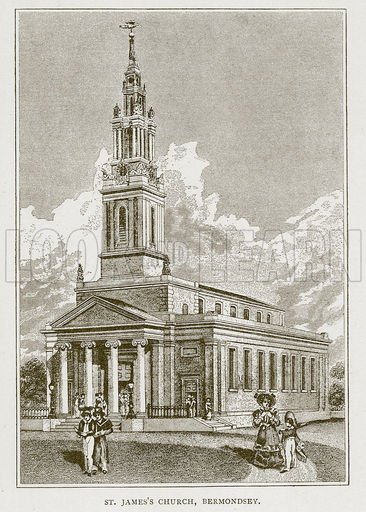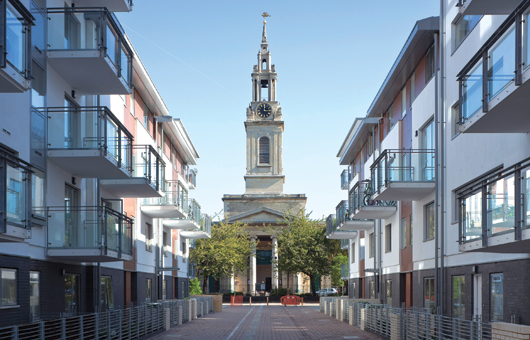History of St James
 Our History
Our History
Travellers through Bermondsey all know St James' Church as a landmark - by road, rail and from the air, the dragon on the steeple rides calmly amid the tower blocks and acres of housing estates.
Before 1829, when the church was consecrated, the only church in the whole of Bermondsey was the Parish Church of St Mary Magdalen, at the end of Bermondsey Street. In 1724 at the Bishop's Visitation, it was recorded "In Bermondsey there are 9,000 people".
The only houses were along Bermondsey Wall, which was part of the only road or highway from the City out into Kent. Here wealthy merchants had magnificent houses. The first streets in our Parish were Salisbury Street and Janeway Street. Here a rich West India Merchant built a house and called it Jamaica House, after the island from which his fortune was derived. By 1710 there were enough poor people living here for it to be necessary to provide a workhouse for 50 people.
In the 18th century ropemakers settled here and in Bevington Street, Farncombe Street and New Church Street (later called Llewelyn Street) ropewalks were established and houses sprang up so that it became necessary to build a new road - Jamaica Road.
Between 1825 and 1830 our end of Abbey Street and a few houses along the line of Spa Road were built. In Jamaica Road only the south side was inhabited in large houses with a view from back windows over open country. As late as 1870/80 there was a farm in Tranton Road.
After Waterloo in 1818 an Act of Parliament was passed to raise a million pounds as a national thank-offering for peace, and as a memorial to the soldiers who had fallen. South London secured seven of the so-called Waterloo Churches which it was decided to build with the money, and, through the persistence of a group of Bermondsey churchmen, the needs of our area were pressed, and in 1821 they bought the land which forms our churchyard and secured a generous grant from the Commissioners of the Fund.
The Chairman of the Committee was William Nottidge, a wool-stapler; with him were two brothers, William George and Richard King Watts, tanners; John Harcourt, Thomas Keeton and Martin Carter, all builders, Robert Rich, who commanded the Bermondsey Volunteers and Dr William Harrison, one of the two Chaplains of St Saviour's, Southwark (now Southwark Cathedral).
Then came 6 years delay - the committee wanted a tower and a spire but there was not enough money. They devised a scheme - to build a crypt under the church in which bodies could be buried; this would provide a steady income. On this security the trustees received permission, by Act of Parliament, to raise £3,000.
With a liberal grant on the part of the parishioners and the gift of the
Commissioners,the contract for the building of the church for £21,412.19.5 wassigned and the first stone laid on the 21st February, 1827. Dr Sumner, Bishop of Winchester, consecrated the church on May 7th, 1829.
"The building will hold 2,000 persons, of whom 1,200 are accommodated in free seats". But the spire (copied from Wren's at St Stephen's, Walbrook) cost £2,300 more, so in 1831 a new Act of Parliament had to be passed to borrow this further sum. By 1840 the last loan had been repaid and the church was free of debt.
James Savage, the architect, modelled the church on that of Greek Temples with galleries round three sides and the organ in the west. Competent authorities declare that St James' Church is the finest church built by the Waterloo Churches Commissioners.
The lectern and pulpit were built very high to keep the minister in touch with the galleries.
A glorious peal of 10 bells was cast by the famous foundry of Mears of Whitechapel, from cannon left behind by Napoleon at Waterloo. A four-faced striking clock, costing £160, was put in the tower. The Organ, built by J.C. Bishop in 1829 is described in our heritage booklet.
Gifts of silver Communion vessels were received from some of the original members of the Committee whose energies resulted in the building of the Church, and the Clock in the West Gallery was given by J.T. Martin.
The Church now built was dedicated to St James but everyone called it Bermondsey New Church. Its grandeur recalling the days when wealthy merchants still lived in Grange Road and Jamaica Road.
St James Today
In the last fifteen years the entire church building, including the historic organ and the Ascension picture, has been extensively restored. The bells once again ring out over Bermondsey each Sunday morning and the Great West Doors are opened wide to welcome the people of the parish to worship the Lord Jesus Christ and hear his Gospel proclaimed.
 A new vista of St James Church from the Bermondsey Spa development
A new vista of St James Church from the Bermondsey Spa development
